Guest post by Angela Ghirardi, Professor of the History of Art at the University of Bologna until 2018
Suor Orsola Maddalena Caccia—or simply Sister Orsola, as she signs herself in one instance, in the 1648 altarpiece discussed below—was an Ursuline nun. She spent most of her life in the convent, praying and painting. In her fifty or so years of artistic activity, she produced a large quantity of paintings, many of which have yet to be traced and studied. She is not the first, nor the only, painter-nun—think, for example, of the Dominican nun Plautilla Nelli (1524–1588), who was so highly praised by Vasari. But she stands out for the abundance and quality of her works. Suor Orsola’s output was so extraordinary that in the late eighteenth century, the abbot Luigi Lanzi compared her to the famous professional painters Lavinia Fontana (1552–1614) and Artemisia Gentileschi (1593–1656).
Suor Orsola was born in Moncalvo, an important Italian village, now in the province of Asti, in Piedmont. During the seventeenth century, Moncalvo was included in the Duchy of Mantua and Monferrato, ruled by the Gonzagas. Baptized on December 4, 1596 with the name of Theodora, she was fortunate enough to have a painter father who, as happened with many artists of his era, acted as a teacher by exposing his daughter to painting and allowing her to develop her talents. Guglielmo Caccia (1568–1625), Theodora’s father, was a highly regarded painter. He was especially active between Piedmont and Lombardy, and he was celebrated as a devoted champion of Counter-Reformation art. His style, with its clear and pleasing composition, which draws on the tradition of the great Lombard painters of the early sixteenth century (Gaudenzio Ferrari) and the sophisticated Tuscan-Roman form of Mannerism (Federico Zuccari), has an unmistakable influence on his painter-daughter.

At the age of twenty-four, in 1620, Theodora took the veil and became Sister Orsola Maddalena. She entered the Ursuline order at the monastery of Bianzè (Vercelli), where four of her sisters had already taken their vows. The Immacolata between Saint Charles Borromeo and Saint Jerome (fig.1) in the church of Santa Giulia, in Monastero Bormida (Asti), dates from the Bianzè years. In it, the young painter demonstrates a close understanding of her father’bs style, as well as her knowledge about the appropriate arrangement of the sacred figures and of symbols such as roses and lilies. Among the clouds around the Virgin in the golden sky, she includes Marian symbols, many of which derive from the invocations of the Loreto litanies or recur in prayers—the tabernacle, the temple, the fountain, the door of Heaven, the ladder of Paradise, the mirror, the well, the tower. More rare, on the right, above the head of St. Jerome, is an image of an animal skin, presented as if lying on the ground. This icon alludes to the fleece of Gideon, the biblical episode from the Book of Judges which, from the end of the Middle Ages, became a symbol of the Virgin Birth.
Suor Orsola remained in Bianzè until 1625 when her father Guglielmo, a few months before he died, allocated part of his house and money to found a convent in Moncalvo. He sought and received permission to erect the new convent from the bishop of Casale Monferrato, the Mantuan nobleman Scipione Agnelli (1593–1653), and soon all six of the Caccia sisters moved there. According to the contemporary writers, the youngest sister Francesca, who went by the religious name Sister Anna Guglielma, was also a painter. But no trace of her artistic activity remains, probably due to her early death.
Sister Orsola spent the rest of her life in the Ursuline convent of Moncalvo, which at the outset was almost an extension of the Caccia family home. She developed a very authoritative personality, often playing the role of abbess. She continued to paint, and she taught painting to those of her conventual sisters who were artistically inclined.
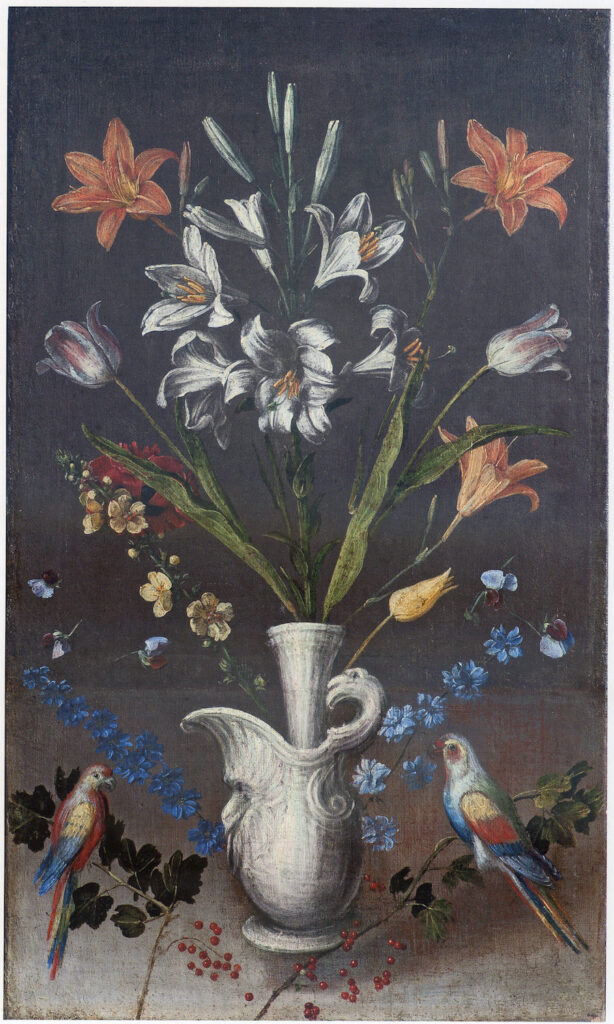
It was probably during the 1630s that she began painting still lifes. Although they represent only a small portion of Sister Orsola’s artistic output, it was her still lifes that first attracted the interest of scholars: these works are notable for their pictorial quality and their deep spiritual meaning. Consider the three flower vases held at the Civic Museum of Moncalvo, featuring a white lily (fig. 2), a red peony (fig. 3), and a yellow sunflower (fig. 4). Each is placed in the center of an elaborate vase with several openings, surrounded by other flower stalks, birds, and fruits.

In the silence of the cloister, Sister Orsola looks at the colorful spectacle of Creation as a symbolic world. Inspired by St. Francis de Sales’ conception of prayer as a collection of flowers from a garden, she transforms the seventeenth-century passion for florilegi (catalogs of flowers)—think of Basilius Besler’s Hortus Eystettensis (Eichstätt, 1613), or the De florum cultura of the Jesuit Giovanni Battista Ferrari (Rome, 1633)—into a form of “Christian botany.” Sister Orsola’s flowers converge in balanced symmetries, like musical notes, without a specific structure. They are visions of Paradise—the original portrayal of which is a garden, after all—prayers raised to Heaven, meditations raised to the mysteries of faith, which serve to arouse in the viewer a yearning for spirituality and devotion.

For many years, Sister Orsola applied herself to the “pious virtue of painting,” as her confessor put it in 1643, working above all for the churches and convents around Moncalvo. Her painting Saint John the Baptist (fig. 5), in the parish church of Montemagno (Asti), is a case in point. The work was commissioned by the parish priest don Giovanni Alessi, who paid for it with alms he collected from all the villagers. On June 23, 1644, he had a contract drawn up with the Ursuline convent, as reported on the cartouche, partially legible at the bottom left of the painting, next to the saint’s foot. This altarpiece demonstrates Sister Orsola’s artistic maturity.
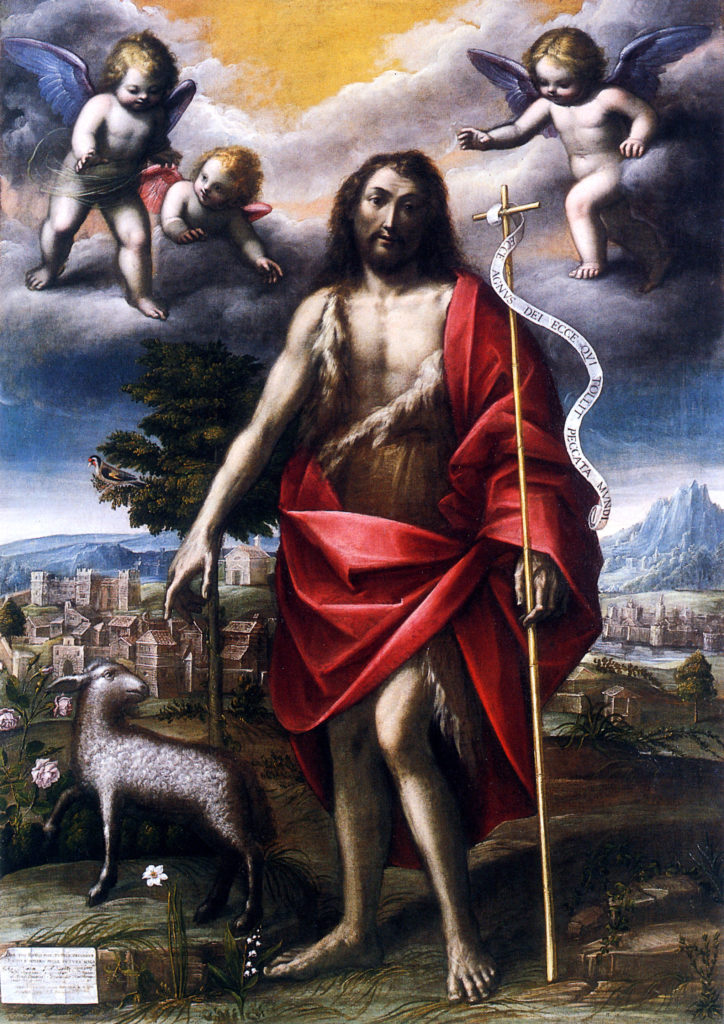
At the center of the painting is Saint John, emaciated from fasting. Three little angels rush among the clouds. The symbolic bestiary includes the lamb, the “Lamb of God who takes away the sins of the world,” to which the saint points, and the goldfinch, alluding to the Passion of Christ. In the foreground are roses, narcissus, and lily of the valley; all of the flowers are depicted with the utmost care. In the distance is an evocative view of the town of Montemagno, on which the saint extends his protection.
Suor Orsola was also in contact with the courts of the Savoys of Turin and the Gonzagas of Mantua. We know of two letters from 1643 that the painter, then abbess of the convent, sent to Madama Reale Christine of France, Duchess of Savoy, in which she solicits commissions, politely explaining that she needs work in order to support her community during a time of economic hardship. The painter-nun must also have been known in Mantua, then the capital of the Duchy to which Moncalvo belonged, since in 1665 two of her paintings were recorded in the Gonzaga collections.
One of Sister Orsola’s most beautiful paintings, certainly the most inspired, was made for one of the most trusted courtiers of the Duchess Maria Gonzaga, then regent of the Duchy. This work is the Mystic Marriage of Blessed Osanna Andreasi (fig. 6), now in the Diocesan Museum of Mantua. On the back it is signed and dated 1648; it was commissioned by the Mantuan count Scipione Agnelli, bishop of Casale Monferrato from 1624. It was Agnelli who granted permission to found the monastery of Moncalvo in 1625 (as stated above) and, over the years, he had stayed in contact with the Ursulines. He had occasion to meet with Sister Orsola, often in her role as abbess, sometimes in connection with her painting. When he decided to entrust her with the execution of the altarpiece dedicated to Osanna Andreasi (1449–1505)—the Blessed Mantua, of the Dominican Third Order, and friend of Isabella d’Este—he was thinking about his fief of Carbonarola (tiny village of Oltrepò Mantua), where he often went and where for centuries his family owned huge landholdings and a large palace.
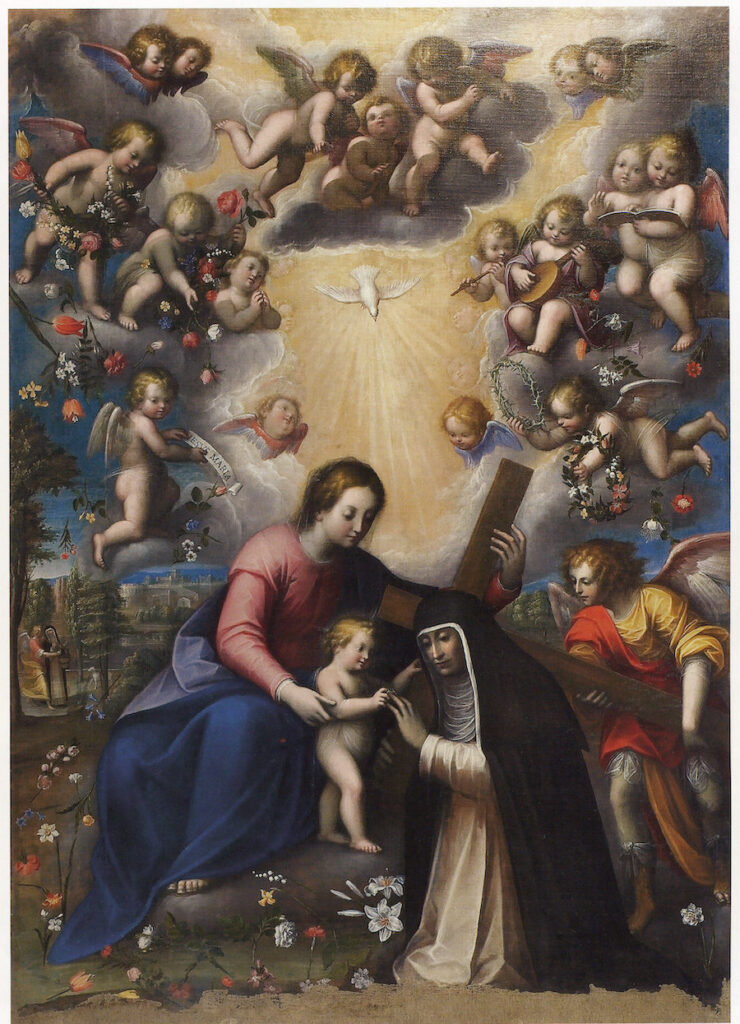
The Mystic Marriage of Blessed Osanna Andreasi was destined to be the main altarpiece of a new church, which he had built at his own expense. It was completed in 1649, on the bicentenary of the birth in Carbonarola of the Blessed Osanna. There was a fruitful exchange of ideas between Bishop Agnelli and Sister Orsola, as evidenced by the fact that the episodes the painter illustrates are set in Carbonarola, and follow the narration that Scipione Agnelli recorded in his Annals, published posthumously in 1675. (The main episode is the mystic wedding, with the Infant Jesus putting the ring on the finger of the Blessed Osanna. The secondary episode is the one of the angel who helps Osanna to carry a heavy bucket of water drawn from the river Po, to the left and in the distance.)
The altarpiece features a festive swirl of little angels around the whirlpool of light in the center. Some scatter flowers, others play and sing, there is the one, on the left, which bears the IESUS MARIA cartouche, to commemorate the miracle of Osanna, who learned to read and write at the sight of the two sacred names. Flying in at the right is an angel that bears a crown of thorns and a crown of flowers, representing martyrdom and glory. Clothed in Dominican robes and kneeling, the blessed Osanna receives the ring, while an adolescent angel places a large cross on her shoulders which the Virgin, with a tender gesture, tries to hold back to reduce its weight. Precisely depicted flowers float everywhere, defying the laws of gravity and spreading the sweet scent of paradise.
A splendid vase of flowers features in Sister Orsola’s Saint Anthony of Padua with the Infant Jesus (fig. 7) in the church of Sant’ Andrea Apostolo in Castelnuovo Don Bosco (Asti). This is one example of an illustration of a saint who appears often in the sacred paintings of Sister Orsola.
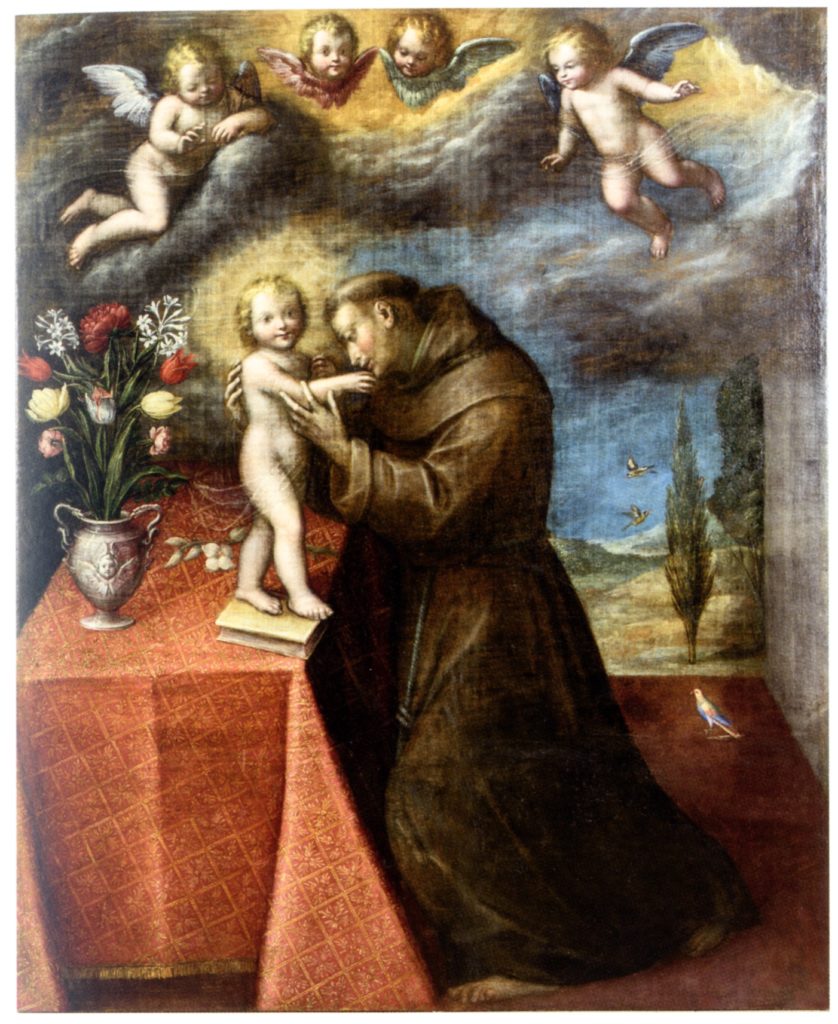
Sister Orsola’s predilection for angels is manifested in the Concerto (fig. 8), held in the Civic Museum of Casale Monferrato. On the basis of characteristic attributes—the scale, the shield and the sword—one recognizes the archangel Michael on the left, intent on playing the violin. At the center the archangel Gabriel, identified by the lily, plays the lute. On the right, directing the music, is the archangel Raphael, with the score in his hand and a jar of ointment beside it.

The attributes recall, in order, the Last Judgment with Saint Michael the Archangel weighing the souls and chasing the reprobates to hell; the annunciation of the archangel Gabriel bearing the lily of the Virgin; and the biblical story of Tobias who, helped by the archangel Raphael, cured his father’s blindness with the ointment. The fourth figure, squeezed between Michael and Gabriel, is devoid of attributes; this angel is represented in the act of singing, with eyes to the sky and a score in hand. It is perhaps Uriel, the least well known of the archangels, here called into service to complete the celestial musical quartet. At the right corner, Sister Orsola painted the fronds of a tree and roses, which according to some is almost a floral signature.
Finally, for those who wish to learn more about Sister Orsola and her art, I recommend consulting these recent catalogs from exhibitions in San Secondo di Pinerolo and Mantua, which offer a wider bibliography:
- Orsola Maddalena Caccia, by Paola Caretta, Daniela Magnetti, Savigliano: L’Artistica Editrice, 2012)
- (Osanna and Orsola: art history and faith in the seventeenth century between Mantua and Monferrato [Osanna e Orsola: arte, storia e fede nel Seicento tra Mantova e il Monferrato], by Angela Ghirardi, Rosanna Golinelli Berto, Mantova: Casandresi, 2018).
Dr. Angela Ghirardi taught “Comparative History of European Art in the Modern Age” at the University of Bologna until 2018. She has devoted much research to Bolognese painting in the second half of the sixteenth century (particularly Bartolomeo Passerotti and his workshop), to portraiture and genre painting with scenes of humble and everyday life, and to women painters of the sixteenth and seventeenth centuries (Lavinia Fontana, Orsola Maddalena Caccia). Among her main publications are: Lavinia Fontana allo specchio. Pittrici e autoritratto nel secondo Cinquecento, in Lavinia Fontana, 1552–1614, exh.cat. Bologna, edited by V. Fortunati; Ritrattisti e ritratti in Emilia-Romagna. Una traccia (2013); Pittura e vita popolare. Un sentiero tra Anversa e l’Italia nel secondo Cinquecento (2016); and Carbonarola 1648–1649: la beata Osanna dipinta da suor Orsola e gli altari della fondazione, in Osanna e Orsola. Arte storia e fede nel Seicento tra Mantova e il Monferrato, exh.cat. Mantova, edited by A. Ghirardi, R. Golinelli Berto (2018).
Visit Art Herstory’s Orsola Maddalena Caccia resource page, here.
More Art Herstory blog posts about artists-nuns:
Plautilla Nelli and the Restoration of her Altarpiece Madonna del Rosario. by Jane Adams
Sister Eufrasia Burlamacchi (Lucca, 1478–1548), by Dr. Loretta Vandi
Sister Caterina Vigri (St. Catherine of Bologna) and “Drawing for Devotion,” by Dr. Kathleen G. Arthur
More Art Herstory blog posts about Italian women artists:
Plautilla Nelli and the Workshop of Santa Caterina in Cafaggio, by Alessia Motti
Roma Pittrice: Women Artists at Work in Rome Between the Sixteenth and Nineteenth Centuries, by Alessandra Masu
Maddalena Corvina’s Saint Catherine of Alexandria, by Kali Schliewenz
Portrayals of Mary Magdalene by Early Modern Women Artists, by Diane Apostolos-Cappadona
Judith’s Challenge, from Lavinia Fontana to Artemisia Gentileschi, by Alessandra Masu
Stitching for Virtue: Lavinia Fontana, Elisabetta Sirani, and Textiles in Early Modern Bologna, by Dr. Patricia Rocco
Thoughts on By Her Hand, the Hartford Iteration, by Erika Gaffney
The Restoration of Royalty: Lavinia Fontana’s Queen of Sheba and King Solomon, by Dr. Aoife Brady
Thoughts on Feminist Art History in the Wake of Artemisia: Vrouw & Macht at Rijksmuseum Twenthe, by Dr. Jitske Jasperse
By Her Hand: Personal Thoughts and Reflections on an Exhibition, by Oliver Tostmann
Giovanna Garzoni’s Portrait of Zaga Christ (Ṣägga Krǝstos), by Dr. Alexandra Letvin
Drawings by Bolognese Women Artists at Christ Church, Oxford, by Jacqueline Thalmann
Lavinia Fontana and Elisabetta Sirani at the Smith College Art Museum, by Dr. Danielle Carrabino
Artemisia Gentileschi: What Wasn’t in the London Exhibition and Why it Matters, by Dr. Jesse Locker
Elisabetta Sirani of Bologna (1638–1665), by Dr. Adelina Modesti
“Artemisia” at the National Gallery: A Review, by Dr. Sheila McTighe
Lavinia Fontana: Italy’s First Female Professional Artist, by Dr. Elizabeth Lev
Plautilla Bricci (1616–1705): A Talented Woman Architect in Baroque Rome, by Dr. Consuelo Lollobrigida
Two of a Kind: Giovanna Garzoni and Artemisia Gentileschi, by Dr. Mary D. Garrard
Warp and Weft: Women as Custodians of Jewish Heritage in Italy, by Dr. Anastazja Buttitta
Rediscovering the Once Visible: Eighteenth-Century Florentine Artist Violante Ferroni, Guest post by Dr. Ann Golob
A Tale of Two Women Painters, Guest post / exhibition review by Natasha Moura
Renaissance Women Painting Themselves, Guest post by Dr. Katherine McIver
The Priceless Legacy of Artemisia Gentileschi: A Curator’s Perspective, by Dr. Judith W. Mann
Relating to Orsola Maddalena Caccia:
Art Herstory’s Orsola Maddalena Caccia resource page
The Metropolitan Museum of Art Acquires Three Paintings by Orsola Maddalena Caccia
The Inaugural Art Herstory Christmas Card (Caccia’s Nativity)
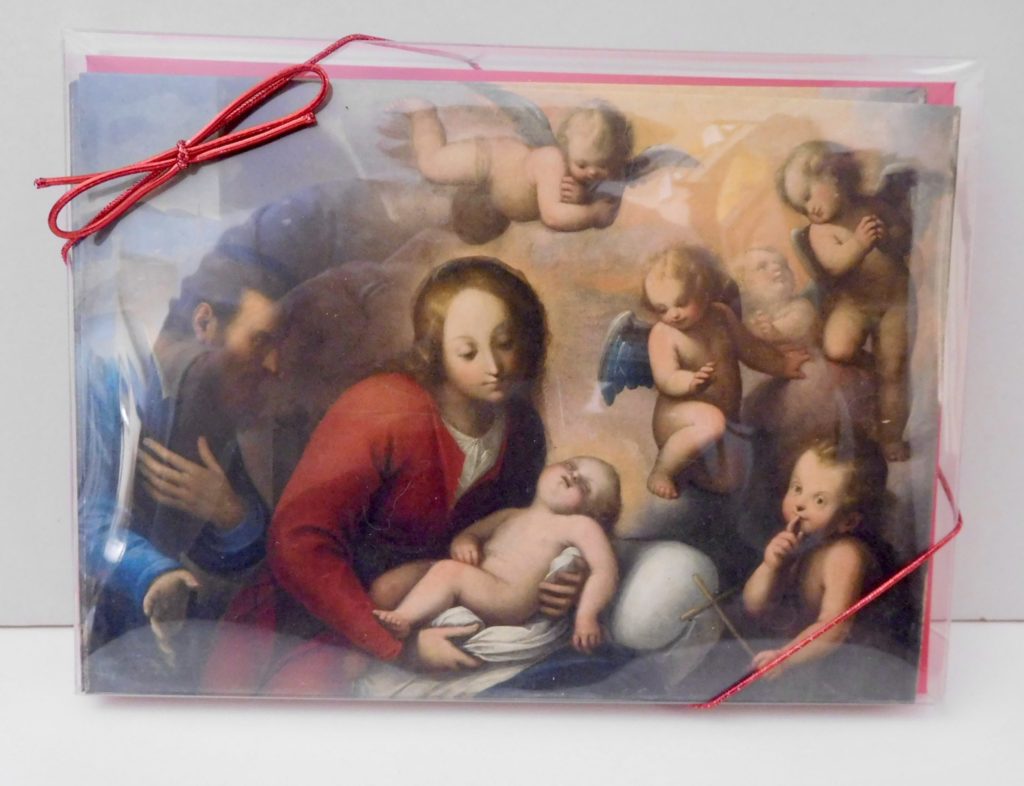



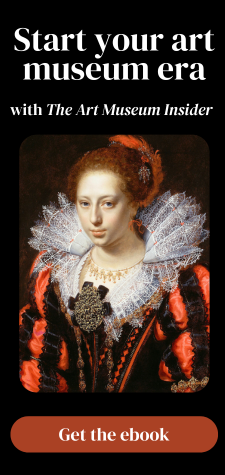

Trackbacks/Pingbacks